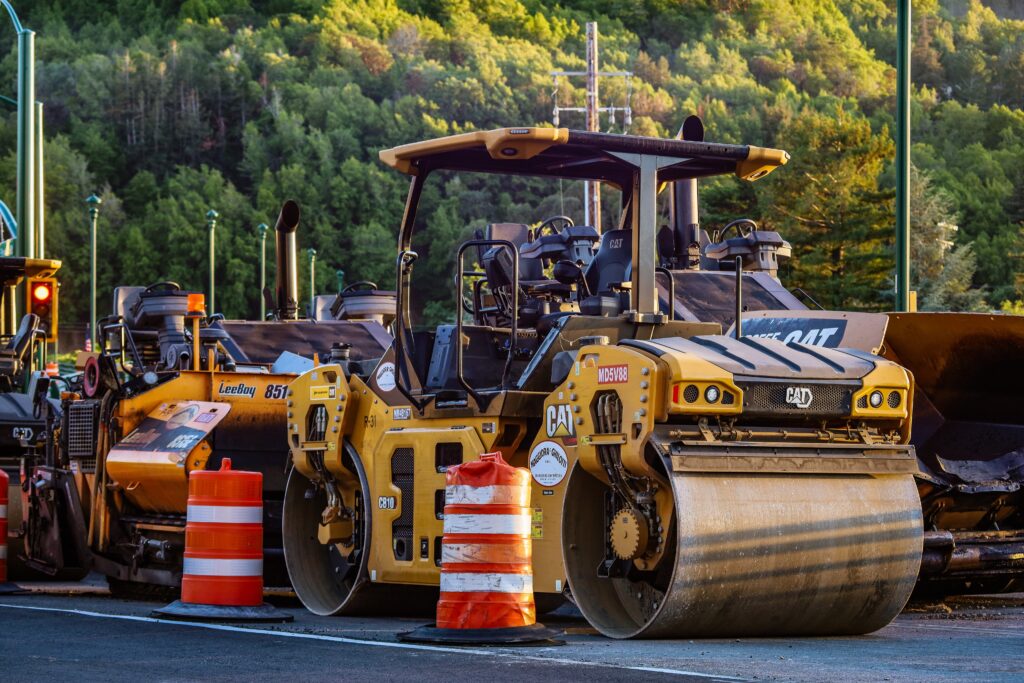Non-road mobile machinery (NRMM) such as excavators, dozers, mining trucks, forklifts, etc. are integral to operations in construction, agriculture, mining, and other industries. With stricter emissions regulations and sustainability goals, electrification is gaining momentum in the NRMM sector. However, setting up adequate charging infrastructure remains a major challenge.

Key Challenges in NRMM Charging Infrastructure
The transition to electric non-road mobile machinery poses challenges for charging infrastructure. But what are these challenges? Let’s take a look:
Limited Grid Access at Remote Sites
Many NRMMs operate at remote sites like mines, farms, or outdoor construction areas with limited access to the electric grid. Moreover, laying new cables and setting up transformers at each site involves high costs.
Without adequate grid power, installing high-capacity EV chargers is not feasible. Providing sufficient electrical capacity requires upgrading local distribution infrastructure, which could take years and have uncertain returns on investment.
High Power Charging Requirements
NRMM are high-power machines with large batteries. For instance, an electric mining truck may have a 600 kWh battery pack. So charging quickly is essential to maximize uptime. This requires chargers capable of very high power delivery up to 1 MW.
The high cost and large footprint of such ultra-high power chargers make deployment difficult. Furthermore, the sheer scale of the infrastructure required poses financial and logistical challenges.
On-Board Charging Limitations
On-board chargers on NRMM are currently limited to 50-150 kW. Charging a large 400-600 kWh battery pack takes multiple hours using just the on-board charger. To enable rapid charging, external high-powered chargers are needed. Retrofitting existing NRMM with larger onboard chargers is complex and also expensive.
Charging Fleet Vehicles Simultaneously
At sites with multiple NRMM vehicles, charging several machines together can overload the grid. The combined load of multiple EVs charging simultaneously could exceed the local grid capacity. Smart charge management is needed to schedule charging and avoid overloading transformers. However, developing smart charging systems optimized for NRMM is still a work in progress.
Exposure to Harsh Environments
Dust, moisture, extreme temperatures, and vibration affect NRMM chargers. Charging hardware designers must ruggedize the equipment to withstand these harsh conditions, which raises costs.
Additionally, liquid cooling systems might be necessary to manage the high thermal loads generated by ultra-fast charging. Ensuring reliability with adequate protections adds complexity.
Lack of Charging Standards
There are currently no universal standards for NRMM EV charging. So this makes it hard to scale infrastructure as each equipment OEM uses proprietary connectors and protocols. Developing open standards will spur interoperability and economies of scale. Moreover, common battery pack designs will also enable battery swapping.
Potential Solutions
The challenges involved in developing charging infrastructure for non-road mobile machinery are significant. However, it is not insurmountable. This section explores potential solutions that can help enable an electrified NRMM fleet.
By taking a systematic approach that considers the needs of end users and leverages policy, technology, etc., progress can be made.
Battery Swapping
Swapping discharged batteries for fully charged ones avoids lengthy charging downtime. It requires standardized, modular battery packs along with swapping machinery and infrastructure.
But it enables flexible charging off-site without high-power chargers on location. It also allows operators to purchase just batteries and not the chargers.
High Power Pantographs
Pantographs are robotized charging contacts that connect temporarily to NRMM vehicles to charge at up to 600 kW.
Moreover, they enable fast high-power charging without onboard charger upgrades. Electric buses already use pantographs and can be adapted for heavy industrial vehicles. They also avoid modifying NRMM powertrains.
Mobile Charging Stations
Mobile charging trailers with onboard transformers and high-power chargers can provide fast charging at changing locations.
They eliminate large fixed installation costs and can be moved flexibly between sites. Mobile stations also enable charging en route or at temporary sites.
Smart Charge Management
Smart charge controllers can optimize NRMM charging based on priority, battery SOC, grid capacity, etc. They schedule charging to avoid overloads and reduce energy costs via timed charging when rates are lower.
Moreover, smart charging is essential for sites with multiple NRMMs sharing limited grid capacity.
Energy Storage Integration
Battery energy storage systems can store grid power during the day for NRMM charging at night. Onsite solar energy can also be stored and used as required for EV charging.
Moreover, combining storage and solar reduces grid infrastructure upgrade needs and provides sustainable charging.
Microwave Power Transfer
Microwaves can wirelessly transfer power over the air over distances up to 100 meters. This enables contactless dynamic charging of NRMM as they operate.
It removes downtime for charging, improving productivity. Furthermore, technology is still evolving but holds great promise for the future.
Hydrogen Fueling
Hydrogen fuel cell NRMM avoids the need for large batteries and lengthy recharging. It is much faster than EV charging. However, hydrogen production and distribution infrastructure are still in the early stages. Additionally, Costs need to be reduced significantly for viability.
Opportunities for NRMM Charging Infrastructure
This section explores the most promising prospects to rapidly scale up charging for non-road EVs. Capturing these opportunities will pave the way for a zero-emission NRMM fleet and support broader sustainability goals.
Potential for Standardization
Developing open charging standards for NRMM will spur interoperability and economies of scale in infrastructure and EVs. Common battery pack designs will enable battery swapping and modular charging approaches. Moreover, industry collaboration is essential to develop standards.
V2G Capabilities
Large NRMM batteries can provide vehicle-to-grid services when connected to smart bi-directional chargers. They can feed power back to the grid to help balance supply and demand. This provides additional revenue streams to offset charging costs. So managed V2G can support the grid.
Combining Charging With Renewables
Charging hubs for non-road mobile machinery (NRMM) can combine on-site solar PV and energy storage to create self-sufficient charging ecosystems. These also minimize grid infrastructure upgrades and provide sustainable charging from renewable energy.
Building New Business Models
Innovative business models like charging-as-a-service, battery leasing, and charging network subscriptions can accelerate NRMM electrification by reducing upfront costs. Furthermore, customers just pay for charging/swapping services and avoid large capital investments.
Partnerships Between Stakeholders
Partnerships between charging companies, OEMs, fleet owners, and utilities will be instrumental in building out scalable NRMM charging solutions. Moreover, no single stakeholder can address the challenges alone. So collaboration is key.
Government Support Programs
Governments can provide financial incentives, grants, and loans to install NRMM charging infrastructure and upgrade grid capacity. Regulations can also mandate electrification and low-emission zones to drive adoption.
To sum up
Electrifying a large number of construction and industrial machines instead of using fuel is a significant task. It involves spending a lot of money to create new ways to charge these machines with electricity. We need to make fast-charging technology that works well for these machines. This will help solve problems like not having enough electricity, how much power the machines need, how long it takes to charge them, making sure they work with the same standards, and making sure they don’t break down often. We can also look into using things like hydrogen or quickly swapping out batteries to power these machines.
To speed up this change, we can make rules that everyone has to follow, create smart charging systems, and think of new ways to do business in this field. It’s also important for the government and companies to work together and help invest in charging infrastructure. If we all work together, we can create a strong system for charging these machines with electricity, which will help the environment by reducing pollution from these vehicles.

Attending the upcoming 3rd Green Non-Road Mobile Machinery forum in Amsterdam on 19-20 October is the premier opportunity to stay ahead of the curve. Over two days, you will gain insider perspectives from industry pioneers driving this change. Through panels, case studies, and exhibits, you will learn about the latest technological breakthroughs in electrification, alternative fuels, and green propulsion for non-road vehicles.
Networking with executives and engineers shaping regulations and best practices will enable you to contribute to the roadmap for the future. By participating in this influential global forum, you can position your organization at the forefront of green, non-road mobility while shaping discussions that impact your field. Don’t be left behind – register now to attend this must-see event that will inform strategic decisions for your machinery fleet and business





